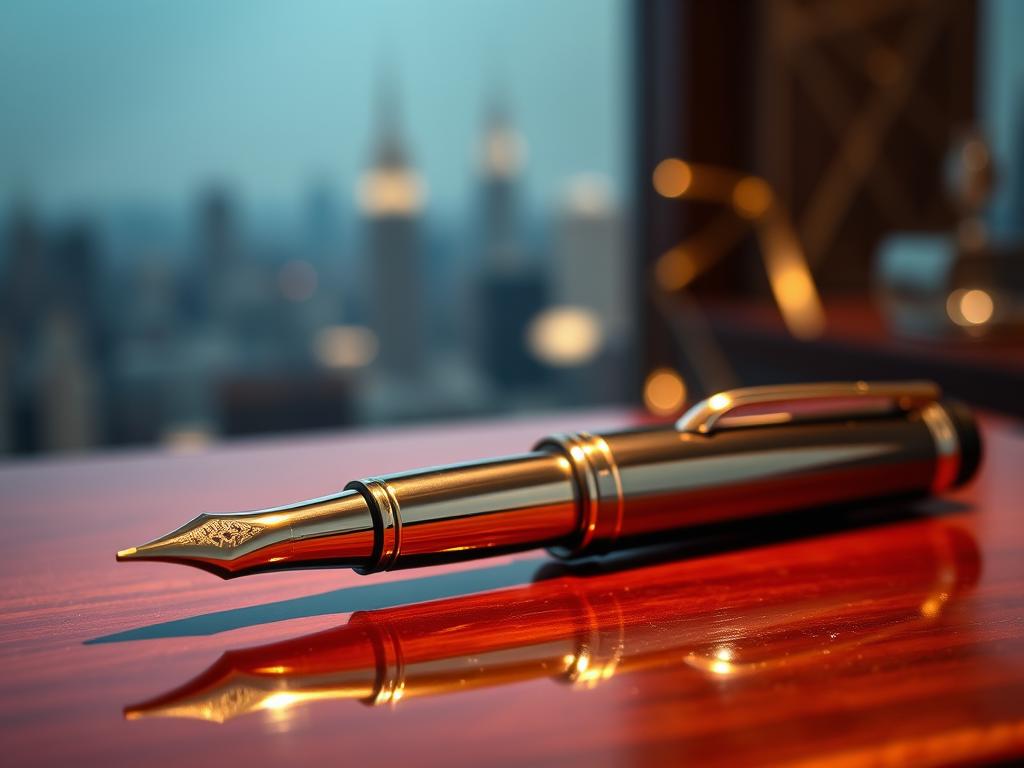Acquiring a premium writing instrument blends practicality with personal expression. While some view these items as simple tools, others cherish them as timeless investments in craftsmanship. The definition of “luxury” varies widely, shaped by individual preferences and financial comfort levels.
Entry-level fountain pens can cost under $65, but the leap into exceptional quality often begins near $500. At this price, heritage brands incorporate meticulous design elements like hand-polished resins or 18-karat gold nibs. These features elevate writing experiences while reflecting decades of artisanal expertise.
Limited edition releases from brands like Montblanc or Pelikan add exclusivity to collections. However, balancing rarity with affordability requires strategy. Savvy enthusiasts prioritize research to identify pieces that align with their tastes and budgets.
Key Takeaways
- Luxury writing tools combine functional design with artistic value
- Premium models often feature gold nibs and specialized craftsmanship
- Price thresholds for high-quality pieces start around $500
- Limited edition releases offer uniqueness but demand careful consideration
- Top brands balance tradition with modern innovation
- Strategic planning enhances long-term satisfaction with purchases
Understanding Luxury Pens: Artistry, Heritage, and Investment
Craftsmanship transforms ordinary tools into cherished heirlooms in the world of fine writing instruments. With the global market for premium pieces valued at over $2.4 billion, brands like Montblanc and Nakaya represent more than status—they embody cultural legacies shaped across generations.
Defining Luxury and High-End Pens
What separates a functional fountain pen from a collectible masterpiece? It often comes down to three elements:
- Materials like urushi lacquer, aged for years before application
- Nibs tuned by master grinders using century-old techniques
- Production numbers under 500 units for limited editions
Consider Pelikan’s M1000 Raden Green Ray. Its nib glides like silk, while the body shimmers with crushed abalone—a combination justifying its $1,200 price. Yet enthusiasts argue the emotional resonance matters as much as technical specs.
The Allure Beyond Functionality
“A great pen isn’t just a tool—it’s a conversation with history,” notes collector Elena Torres. This philosophy explains why vintage Conway Stewart models from the 1930s still command four-figure sums. Their celluloid patterns and flex nibs tell stories of art deco design and pre-war craftsmanship.
Modern brands enhance this narrative through innovations like Sailor’s 21-karat gold nibs or Visconti’s magnetic cap systems. While these features improve writing precision, they also deepen the user’s connection to the piece’s heritage.
Budgeting for Luxury Pen: A Strategic Approach
Navigating the world of high-end writing tools requires a clear financial roadmap. Like any meaningful investment, defining boundaries early prevents overspending while ensuring alignment with personal priorities. Start by asking: What value does this piece bring beyond its basic function?
Setting Your Financial Baseline
Models like the Pelikan M800 ($550) and Lamy 2000 ($200) demonstrate how quality scales with price. The M800’s 18-karat gold nib and piston-filling mechanism justify its premium, while the Lamy’s sleek design appeals to minimalist enthusiasts. Both offer distinct experiences, proving that personal preference often outweighs raw specs.

| Model | Price Range | Key Features | Collectible Value |
|---|---|---|---|
| Pelikan M800 | $500-$600 | Gold nib, hand-polished resin | High (Iconic design) |
| Lamy 2000 | $180-$220 | Stainless steel, Makrolon body | Moderate (Modern classic) |
Higher costs often reflect artistic merit rather than pure utility. Limited editions, like Sailor’s seasonal releases, add exclusivity but demand careful budgeting. Always weigh a pen’s daily usability against its potential as a future heirloom.
Brands position themselves differently—Pelikan leans on tradition, while Lamy champions innovation. Define your non-negotiables: Is it the tactile joy of a gold nib or the storytelling of a rare edition? Let these priorities guide your spending strategy.
Evaluating Limited and Special Editions
Special edition pens often spark excitement, but not all live up to their hype. Distinguishing meaningful exclusives from clever marketing requires a discerning eye. Let’s explore how to spot true value in this crowded space.

Assessing the Limited Edition Designation
A pen’s “limited” status holds weight only when backed by verifiable scarcity. For example, Pelikan’s 2019 M800 Renaissance Brown had just 5,000 units—a stark contrast to brands labeling 50,000 pieces as “special.” Three factors separate genuine rarities:
- Production numbers below 1,000 units
- Unique materials like urushi lacquer or artisan engravings
- Documented brand heritage supporting the release
| Feature | Genuine Limited Edition | Marketing-Driven Edition |
|---|---|---|
| Units Produced | 5,000+ | |
| Materials | Handcrafted elements | Standard resin/plastic |
| Secondary Market Value | +20-50% in 3 years | Retail or below |
Balancing FOMO with Practical Considerations
That sinking “missed out” feeling drives many impulse buys. Yet seasoned collectors know better. Montblanc’s 1992 Writers Edition Agatha Christie pen initially sold for $500—now valued at $5,000. Meanwhile, 2021’s “exclusive” Starwalker model still languishes near its $700 retail price.
Before purchasing, ask:
- Will I use this daily, or will it gather dust?
- Does the design align with my existing collection?
- Are there verified reports of quality control issues?
Smart acquisitions blend passion with practicality. Focus on pieces offering both writing joy and potential legacy—like Visconti’s Homo Sapiens series with its lava-resin bodies. These pens deliver unique experiences without relying solely on artificial scarcity.
Quality, Craftsmanship, and the Writing Experience
Superior materials and engineering elevate everyday writing to a sensory experience. When creators blend technical precision with creative vision, they craft instruments that feel like extensions of the hand. These pieces balance durability with beauty, designed to last decades while sparking daily joy.
Materials, Build, and Gold Nibs
High-end writing tools often start with rare celluloids or resins aged for years to achieve depth and luster. Brands like Nakaya use urushi lacquer—a Japanese art form requiring 18 months to cure. Gold nibs remain the gold standard, with 14-karat or 18-karat ones offering unmatched flexibility. Sailor’s Naginata Togi nib, for instance, adapts to writing angles like a brushstroke.
The Role of Filling Mechanisms and Design
Innovative systems transform how pens interact with ink. The Pilot Vanishing Point revolutionized convenience with its retractable nib, while Visconti’s vacuum seal prevents leaks during flights. Compare popular mechanisms:
| Mechanism Type | Best For | Example Model |
|---|---|---|
| Piston | High ink capacity | Pelikan Souverän |
| Cartridge/Converter | Ease of cleaning | Lamy 2000 |
| Vacuum | Travel readiness | TWSBI Diamond 580 |
Ergonomic grips and balanced weights prove crucial for long writing sessions. The Pilot Vanishing Point set a benchmark with its angled clip that naturally guides fingers into position. Such details turn functional items into art pieces that open new windows of creative expression.
Ultimately, a well-crafted pen becomes a companion for years, its design evolving alongside the user’s life story. Whether through heirloom materials or smart engineering, these tools remind us that writing can be both practical and poetic.
Market Timing: When to Make Your Purchase
Timing transforms casual browsing into strategic acquisitions in the world of high-end writing instruments. Savvy collectors know that calendar awareness often proves as valuable as product knowledge. Seasonal patterns and promotional cycles create opportunities to secure premium pieces without compromising financial goals.
Seasonal Sales and Clearance Opportunities
End-of-year events like Black Friday often open new windows for discounts on coveted models. Aurora’s limited edition fountain pens, for example, frequently drop 15-20% during January clearance sales. Retailers clear inventory to make room for spring collections, creating prime chances to access higher-tier items within a comfortable price range.
The Benefits of Patience and Price Drops
Waiting six months after a release can yield surprising deals. One collector snagged Montblanc’s Writers Edition at 30% off by monitoring prices until March. “Impulse buys rarely age well,” they noted. This approach avoids FOMO while aligning purchases with actual price point flexibility.
Leveraging Discount Codes and Promotions
Signing up for brand newsletters unlocks early access to flash sales. The Lamy Studio recently became 25% more accessible through a subscriber-exclusive code. Key tactics include:
- Tracking anniversary sales from authorized dealers
- Using price-tracking tools for historical data
- Combining store coupons with seasonal promotions
Strategic timing ensures every purchase delivers both an exceptional writing experience and lasting value. By aligning acquisition plans with market rhythms, enthusiasts build collections that satisfy both heart and wallet.
Balancing Investment with Everyday Use
The true value of a premium writing instrument reveals itself through daily interaction. Collectors face a constant tug-of-war between preserving pristine condition and enjoying tactile satisfaction. How does one honor craftsmanship while letting art live through regular use?
Functionality Versus Collectibility
Models like the Pelikan M800 showcase this duality beautifully. Its 18-karat gold nib offers buttery smooth strokes, while the iconic design ensures lasting desirability. “A pen that stays in its case is like a songbird that never sings,” notes longtime user Marco Silva.
The Lamy 2000 takes a different approach with its understated Makrolon body. Its minimalist aesthetic hides clever engineering—perfect for those prioritizing stealthy elegance over flashy displays. Both pieces prove that daily use needn’t diminish collectible appeal when chosen wisely.
| Model | Weight (grams) | Grip Style | Investment Potential |
|---|---|---|---|
| Pelikan M800 | 35 | Contoured | High |
| Lamy 2000 | 25 | Tapered | Moderate |
| Kaweco Sport | 18 | Compact | Low |
| Pilot Vanishing Point | 30 | Retractable | Growing |
Ergonomics play a crucial role in this balance. The Kaweco Sport’s pocket-friendly design encourages constant carry, while the Pilot Vanishing Point’s click mechanism suits quick notes. Heavier pens might impress at meetings but tire hands during marathon journaling sessions.
Ultimately, the choice hinges on personal rhythms. Do you reach for your pen multiple times daily or reserve it for special occasions? Answering this honestly helps align purchases with actual needs rather than hypothetical scenarios.
Conclusion
Selecting a writing instrument that resonates personally involves balancing technical precision with emotional connection. Whether drawn to the reliability of a steel nib or the engineering of advanced filling mechanisms, enthusiasts find value in pieces that mirror their unique rhythm.
Strategic spending requires understanding market trends and personal priorities. Limited editions demand scrutiny—their worth lies in authentic craftsmanship, not artificial scarcity. Tools like the executive fountain pen demonstrate how design excellence pairs with daily utility.
Every choice carries dual potential: a trusted companion for today and a legacy item for tomorrow. Market growth projections—from $2.4 billion to $3.6 billion by 2031—highlight rising appreciation for artful tools. Yet the wisest selections blend research with instinct, honoring both wallet and creative spirit.
Ultimately, these instruments transcend their role as mere writing tools. They become extensions of identity, merging heritage with innovation in every stroke. The artistry lies not just in their construction, but in the thoughtful process of choosing them.
FAQ
What defines a luxury fountain pen compared to standard models?
Luxury pens prioritize craftsmanship, premium materials like gold nibs, and heritage. Brands like Montblanc and Pelikan blend art with engineering, offering unique designs and limited editions that elevate their status beyond basic writing tools.
How do limited editions differ from regular fountain pens?
Limited editions, such as Sailor’s Pro Gear Slim releases or Visconti’s Homo Sapiens series, feature exclusive designs, numbered production, and rare materials. They often appreciate in value, making them collectible investments alongside functional pieces.
Are gold nibs worth the higher cost?
Gold nibs, like those on Pilot’s Custom 823 or Lamy’s 2000, provide a smoother, more responsive writing experience. Their flexibility and durability often justify the price for enthusiasts seeking long-term quality over steel alternatives.
When is the best time to buy a high-end pen?
Seasonal sales, like Black Friday or holiday promotions, often feature discounts on brands like Platinum or Kaweco. Retailers such as Goulet Pens or JetPens also occasionally offer clearance deals on older models.
Should a first luxury pen prioritize function or collectibility?
Start with a versatile model like the Pilot Vanishing Point or Pelikan M800. These balance everyday usability with refined craftsmanship, ensuring practical enjoyment while exploring the hobby before investing in rare editions.
How do filling mechanisms impact the writing experience?
Mechanisms like piston fillers (TWSBI Eco) or vacuum systems (Pilot Custom 823) offer larger ink capacities and smoother operation. They add to the tactile satisfaction of using a fountain pen, enhancing its overall appeal.
Can limited editions be used daily, or are they too fragile?
Many, like the Leonardo Momento Zero Grande, are built for regular use despite their exclusivity. However, delicate finishes or materials in pens like the Nakaya Dorsal Fin may require more careful handling.


